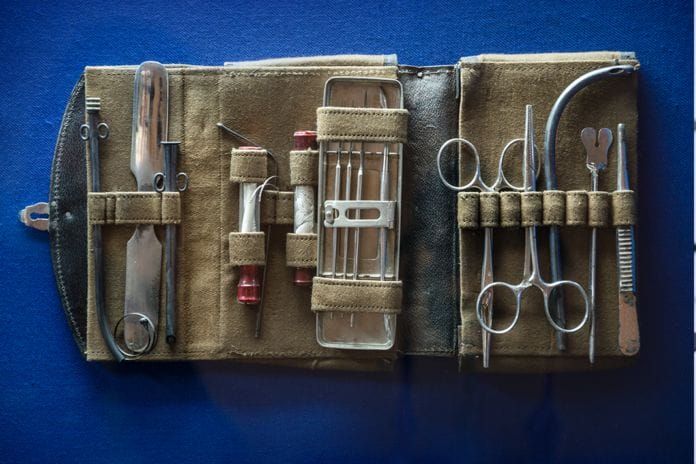As I get older, I notice myself commonly making references to the past by using the phrase, “Back in the day…” Music and television award shows also pay homage to their past and the changes that have taken place over the years. Then, too, education teaches lessons on past world history as it does on current world affairs. History is obviously the foundation on which many institutions build their futures, and the profession of dental hygiene is no exception to this trend.
Recently, one afternoon as I was speaking to my mother, who as a retired dental hygienist herself and had impacted my career choice, mentioned how much the profession has changed over the years. She commented that I am more knowledgeable in all dental aspects then she was through her thirty-eight-year dental hygiene career. Her remarks influenced me to research the history of the dental hygiene profession.
History of Dental Hygiene
Dental Hygiene dates back to over one-hundred years ago and has continued to change and grow over the decades. In 1907, Alfred Fones, a dentist in Connecticut, understood the importance of oral care to reduce the bacteria that caused caries. As a result, he employed his cousin, Irene Newman, and trained her to perform dental prophylaxis on his patients. Irene Newman was the first “dental hygienist” to implement dental hygiene duties in a clinical setting. This precipitated America’s first dental hygiene program established, in Bridgeport, Connecticut, by Dr. Fones in 1913.
Members of Connecticut’s first dental hygiene graduating class of 1914 were employed in a school-based setting in order to emphasize the importance of oral care to children. The school-based programs and hospitals described these pioneering dental hygienists as “dental nurses,” but later Dr. Fones changed their job title to “dental hygienist.” The achievements of Dr. Fones may have also contributed to Bridgeport, Connecticut reporting the lowest death rate of a large city during the Influenza Pandemic of 1918.
First Licensed Dental Hygienist
In 1917, Irene Newman became the first licensed dental hygienist, and within the next three years, six more states followed and licensed dental hygienists. The ADHA was then established in 1923 with forty-six members, and the growth of the dental hygienist profession continued. By 1952, all fifty states had licensed dental hygienists.
As the dental hygienist programs spread worldwide, the ADHA implemented requirements for program admissions. In 1935, a high school diploma was mandatory for licensure. By 1940, a two-year course of study was also required to become licensed as a dental hygienist. The ADHA then adopted the “Registered Dental Hygienist” label in 1940. Finally, the first regional board examination was given in 1968.
Advances in Dental Hygiene
The advancement of the dental hygiene profession introduced new technology through the years. In 1945, Dr. Clayton Gracey developed the Gracey curettes. By the 1950’s, the first ultrasonic scaler was introduced and fully reclining dental chairs were manufactured. In 1981, an ultrasonic scaler with a prophy jet was designed to replace rubber cup polishing. The 1st Edition of Clinical Practice of The Dental Hygienist, otherwise known as “the Dental Hygiene Bible,” was published by Dr. Esther Wilkins. All of the above are still readily used today in the dental hygiene setting.
The 1950’s and 1960’s brought about the Civil Rights Act. This had a positive influence on the dental hygiene industry. The ADHA lifted its restrictions for admissions, such as race, color, and creed. In 1964 “Female” was deleted from the ADHA Constitution which paved the road for the first male dental hygiene graduate, Jack Orio, in 1965.
Dental Hygiene Continuing Education
By the 1970’s the ADHA established guidelines for continuing education for dental hygiene. The 1980’s were a turning point in the hygiene industry when Washington became the first state to implement the unsupervised practice of dental hygiene in specific settings. This resulted in Colorado and other states to follow Washington State’s initiative over the next two decades. The 1990’s were instrumental to dental hygiene when fourteen states elected to allow registered dental hygienists to administer local anesthesia. By 2000, over half of the fifty states allowed local anesthesia administration by a Registered Dental Hygienist.
Another historic milestone was the HIV/AIDS epidemic of the 1980’s. Although OSHA was established in 1971, personal protective equipment was not mandated until 1988. However, OSHA’s Bloodborne Pathogen Standards did not become effective for clinical dental professionals until 1991.
When I asked my mother what she made as a dental hygienist following her graduation in 1968 she replied, “$90 per week for a thirty-two hour work week” in a private practice setting. By contrast, the median pay for a dental hygienist recorded in 2017 was $35.61 per hour. Further research also reveals the average fee for an adult prophylaxis in 1975 was $13.58 and $22.41 in 1982. Since then, from 1985 to 2011, dental goods and services have increased by 109%.
There has been a rise in registered dental hygienists over the years, but a decline in dentists. In 1950 dentists made up 51% of the dental profession, whereas dental hygienists only accounted for 2%. In 2000, these percentages rose 20% with a fifty-fifty ratio of dentists to dental hygienists. The population seeking dental treatment annually has also increased over the years. In the 1950’s less than one-third of the population was seeking annual dental visits. This number had climbed to over 67% by the early 2000’s.
As the dental hygiene industry grows, it is important to look back to where we started and what we have achieved over the last one-hundred years. Public awareness of the relationship between overall health and dental health has broadened. Also, our skill set as registered dental hygienists has increased significantly over time. History has played a meaningful role in our advancement and looking ahead we can only hope that history will repeat itself and allow for more advancement during our careers as registered dental hygienists.
Before you leave, check out the Today’s RDH self-study CE courses. All courses are peer-reviewed and non-sponsored to focus solely on high-quality education. Click here now.
Listen to the Today’s RDH Dental Hygiene Podcast Below:
SEE ALSO: Dr. Esther Wilkins and a Century of Change
DON’T MISS: Dedication to Patient Education
References
- American Dental Hygiene Association (2013). 100 Years of Dental Hygiene Timeline. Retrieved from http://www.tiki-toki.com/timeline/entry/55646/100-Years-of-Dental-Hygiene/.
- Eric S. Solomon (2012). The Past and Future of Dental Workforce Team. Journal of Dental Education. August 2012, 76(8):1928-1035. Retrieved from http://jdentaled.org/76/8/1028.
- L. Jackson Brown, Vikie Lazar (1998). Dental Procedures and Fees 1975 through 1995: How much have they changed?. Journal of American Dental Association, September 1998, 129:129-1295. Retrieved from http://jada.ada.org/Soo2-8177(14)66271-1.
- Bureau of Labor and Statistics. Retrieved from https://www.bls.gov/ooh/healthcare/mobile/dental-hygienists.htm.
- Eric Lehman. Retrieved from http://www.pbortlibrary.org/hc/education/dr-alfred-fones/.











